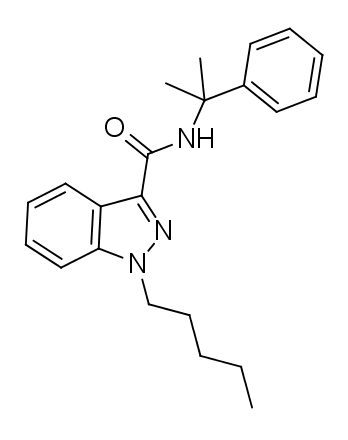Summary
CUMYL-PINACA also referred to as SGT-24, belongs to the class of indazole-3-carboxamide synthetic cannabinoids. It is a robust agonist for cannabinoid receptors, demonstrating about threefold selectivity for CB1. Its affinity for human CB1 receptors is notably high, with an EC50 of 0.15nM, and it exhibits a similar potency for human CB2 receptors, with an EC50 of 0.41nM. In its pure state, CUMYL-PINACA presents as a viscous oil, and direct skin contact with this substance can potentially lead to toxicity.
| Identifiers | |
|---|---|
| IUPAC name | |
| CAS Number | 1400742-15-5 |
|---|---|
| PubChem CID | 86273676 |
| ChemSpider | 48060412 |
| UNII | 3N1P3KD3CV |
| Chemical and physical data | |
| Formula | C22H27N3O |
| Molar mass | 349.478 g·mol−1 |

Legal status
On November 10, 2014, Sweden’s public health agency recommended the classification of CUMYL-PINACA as a hazardous substance.
FAQ
- What is CUMYL-PINACA?
- CUMYL-PINACA, also known as SGT-24, is a synthetic cannabinoid with an indazole-3-carboxamide structure. It acts as a potent agonist for cannabinoid receptors and has been associated with various health concerns.
- How does CUMYL-PINACA affect the body?
- CUMYL-PINACA interacts with cannabinoid receptors, primarily CB1 and CB2. It exhibits a strong binding affinity for these receptors and can lead to various physiological and psychological effects when consumed.
- What are the effects of CUMYL-PINACA use?
- The effects of CUMYL-PINACA use can include altered perception, relaxation, increased heart rate, and a range of other psychoactive effects. It may also lead to adverse effects such as anxiety, paranoia, and hallucinations.
- Is CUMYL-PINACA legal?
- CUMYL-PINACA is classified as a controlled substance in many countries, including the United States and Sweden. It is illegal to manufacture, possess, or distribute this substance in those regions.
- What are the potential health risks associated with CUMYL-PINACA?
- CUMYL-PINACA has been linked to health issues such as hyperthermia, rhabdomyolysis, kidney failure, and, in some cases, death. Its use poses significant health risks, and individuals are strongly advised to avoid it.
- Can CUMYL-PINACA be detected in drug tests?
- Yes, CUMYL-PINACA can be detected in drug tests designed to identify synthetic cannabinoids. It is important to note that many drug tests are updated regularly to see new substances.
- Is there a legitimate or medical use for CUMYL-PINACA?
- No, CUMYL-PINACA does not have any recognized legitimate or medical use. It is solely associated with recreational or non-medical purposes, which are often illegal.
- How can I seek help or treatment for CUMYL-PINACA-related issues?
- If you or someone you know is experiencing health problems or addiction related to CUMYL-PINACA, it is essential to seek professional help. Contact a healthcare provider, addiction specialist, or a local support group for guidance and assistance.
- Is there ongoing research on CUMYL-PINACA?
- Research on synthetic cannabinoids like CUMYL-PINACA is ongoing, with a focus on understanding their effects, risks, and potential treatment options for individuals who misuse these substances.
- Where can I find more information about CUMYL-PINACA?
- For more information about CUMYL-PINACA, you can refer to reputable sources, such as government health agencies, research institutions, and substance abuse prevention organizations. Always ensure that you access information from trusted and reliable sources.
References
- Patent Discovery: A patent application from New Zealand in April 2013 revealed information about cannabinoid compounds, shedding light on substances like CUMYL-PINACA[^1^].
- Transdermal Poisoning: A case study in March 2017 reported a case of occupational transdermal poisoning caused by synthetic cannabinoid cumyl-PINACA[^2^]. The study highlights the potential dangers associated with exposure to these substances.
- Health Classification Proposal: There have been proposals to classify cannabinoids, including CUMYL-PINACA, as hazardous substances due to their potential health risks[^3^]. These proposals emphasize the importance of regulating these compounds.